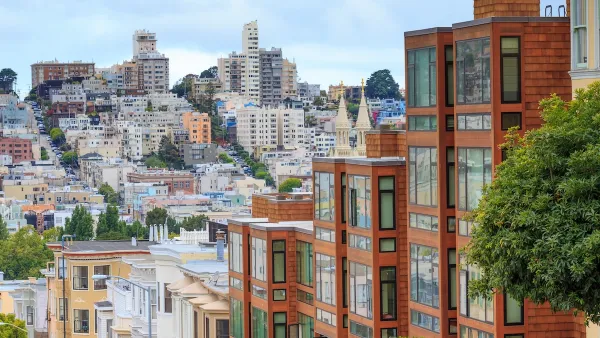In examining the question of whether a new high rise development in San Francisco achieves success at street level, John King picks up an age-old, but always relevant, debate.

John King, urban design critic for the San Francisco Chronicle, reviews the Lumina development in the quickly growing neighborhood of Rincon Hill.
King's main concern is that this "vertical neighborhood" managed to improve life at the street level. The summarized assessment: "Now Lumina is complete, and the ground-level moves aren’t nearly as seductive as those in the air. But they’re a strong addition to their surroundings, and likely to get better with age."
At the street level of this pair of 37- and 42-story high-rises and two eight-story buildings: "a parking garage, and the amenity spaces for residents of the 656 condominiums include a climbing wall, a soundproof music studio and a plush screening room."
"Two essential pieces were missing until last month," writes King: "a 9,500-square-foot grocery store, at the corner of Folsom and Main, and a mid-block plaza between Lumina’s south edge and the Bay Area Metro Center. The latter, home to several regional government agencies, occupies a surprisingly inviting remake of an industrial block by Perkins + Will."
King provides an account of the human experience at the street level of the new development, while the development is a relatively new addition to an urban district in the making.
FULL STORY: Lumina’s sexy, slinky condos work to make Rincon Hill a neighborhood

Maui's Vacation Rental Debate Turns Ugly
Verbal attacks, misinformation campaigns and fistfights plague a high-stakes debate to convert thousands of vacation rentals into long-term housing.

Planetizen Federal Action Tracker
A weekly monitor of how Trump’s orders and actions are impacting planners and planning in America.

In Urban Planning, AI Prompting Could be the New Design Thinking
Creativity has long been key to great urban design. What if we see AI as our new creative partner?

Milwaukee Launches Vision Zero Plan
Seven years after the city signed its Complete Streets Policy, the city is doubling down on its efforts to eliminate traffic deaths.

Portland Raises Parking Fees to Pay for Street Maintenance
The city is struggling to bridge a massive budget gap at the Bureau of Transportation, which largely depleted its reserves during the Civd-19 pandemic.

Spokane Mayor Introduces Housing Reforms Package
Mayor Lisa Brown’s proposals include deferring or waiving some development fees to encourage more affordable housing development.
Urban Design for Planners 1: Software Tools
This six-course series explores essential urban design concepts using open source software and equips planners with the tools they need to participate fully in the urban design process.
Planning for Universal Design
Learn the tools for implementing Universal Design in planning regulations.
Gallatin County Department of Planning & Community Development
Heyer Gruel & Associates PA
JM Goldson LLC
City of Camden Redevelopment Agency
City of Astoria
Transportation Research & Education Center (TREC) at Portland State University
Jefferson Parish Government
Camden Redevelopment Agency
City of Claremont



























